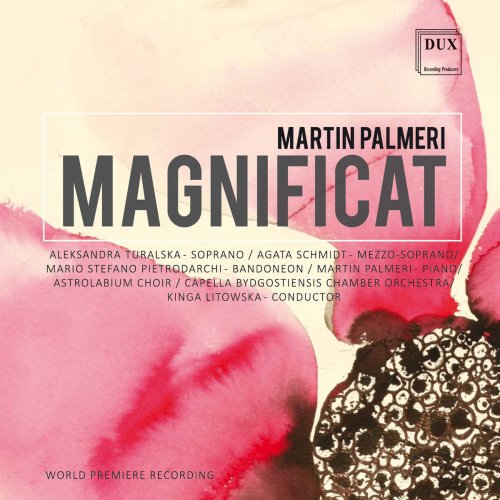Chór Astrolabium, Capella Bydgostiensis & Kinga Litowska - Martín Palmeri: Magnificat (2017)

Artist: Chór Astrolabium, Capella Bydgostiensis, Kinga Litowska
Title: Martín Palmeri: Magnificat
Year Of Release: 2017
Label: DUX
Genre: Classical
Quality: flac lossless
Total Time: 00:46:18
Total Size: 231 mb
WebSite: Album Preview
TracklistTitle: Martín Palmeri: Magnificat
Year Of Release: 2017
Label: DUX
Genre: Classical
Quality: flac lossless
Total Time: 00:46:18
Total Size: 231 mb
WebSite: Album Preview
---------
01. Magnificat: I. Magnificat anima mea Dominum
02. Magnificat: II. Et exutavit spiritus meus
03. Magnificat: III. Quia respexit humilitatem
04. Magnificat: IV. Quia fecit mihi magna
05. Magnificat: V. Et misericordia eius
06. Magnificat: VI. Fecit potentiam
07. Magnificat: VII. Deposuit potentes
08. Magnificat: VIII. Esurientes
09. Magnificat: IX. Suscepit Israel
10. Magnificat: X. Sicut locutus est
11. Magnificat: XI. Gloria
Martín Palmeri began to work on the Magnificat dedicated to mixed choir, soprano and mezzo-soprano solo, string orchestra, bandoneon, and piano in 2010. He was guided by an idea to create a piece, which would be stylistically and emotionally close to the Misa a Buenos Aires – Misatango, yet much more difficult for the performers, and more sophisticated as far as the rhythm and polyphony are concerned. The composition was ended in 2012 and its world premiere took place in Milan. The source of the text of the Magnificat is the Gospel of Luke (1:46-55). The evangelist consciously combines three pictures into a triptych: Annunciation, Visitation, and the Marian Magnificat. The Humble Servant is chosen for the Mother of the Son of God. She starts a journey to visit her relative, Elizabeth, who will soon become mother of John the Baptist. Elizabeth greets Mary and She answers her with words of a canticle praising God. While Palmeri was composing the Magnificat, he was drawing inspiration from the Argentinian tango nuevo popularized in the greatest extent by Astor Piazzolla, who modernized the traditional Argentinian tango and enriched it with elements of jazz and Argentinian folklore; however, the references to the tango in the Magnificat do not concern only the orchestral layer of the piece. Despite the fact that the basic carrier of the tango’s idiom are the bandoneon and the orchestra, its element also crosses the vocal layer of the piece, as it is also the solo voices and choir that abound in the tango rhythms. The bandoneon in Palmeri’s music changes its facets as a chameleon: once it rhythmically energizes the sound layer, the other time it limits itself to highlight the accents occurring on particularly important words, and sometimes it accompanies the solo voices duo, subtly surrounding their narration.


![Don Cherry, Nana Vasconcelos & Collin Walcott - Codona (1979/2025) [Hi-Res] Don Cherry, Nana Vasconcelos & Collin Walcott - Codona (1979/2025) [Hi-Res]](https://www.dibpic.com/uploads/posts/2025-12/1765970766_cover.jpg)


![Sibel Köse Septet - In Good Company (2025) [Hi-Res] Sibel Köse Septet - In Good Company (2025) [Hi-Res]](https://www.dibpic.com/uploads/posts/2025-12/1765846644_uizwujac4ht2d_600.jpg)


![Nectar Woode - Live at Village Underground (Live At Village Underground) (2025) [Hi-Res] Nectar Woode - Live at Village Underground (Live At Village Underground) (2025) [Hi-Res]](https://img.israbox.com/img/2025-12/15/eiazyx7yigt2lhbv1tcd3eos6.jpg)